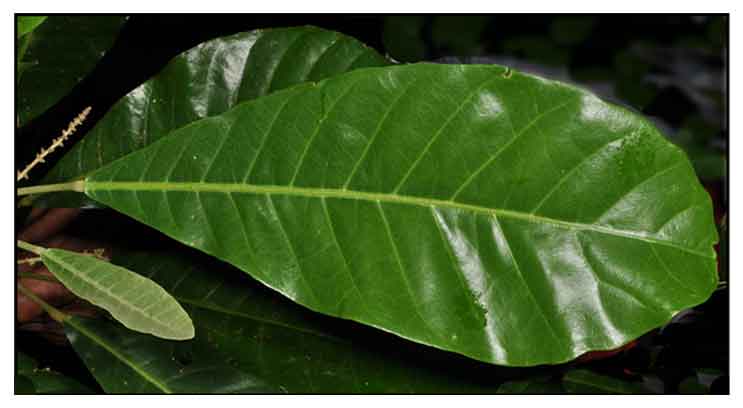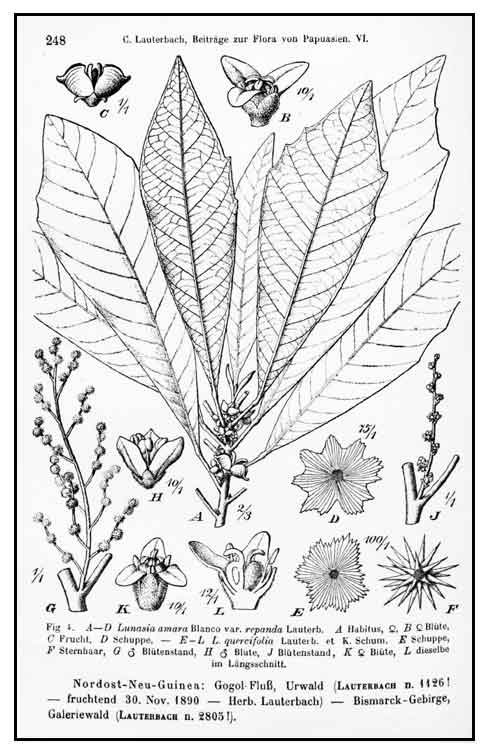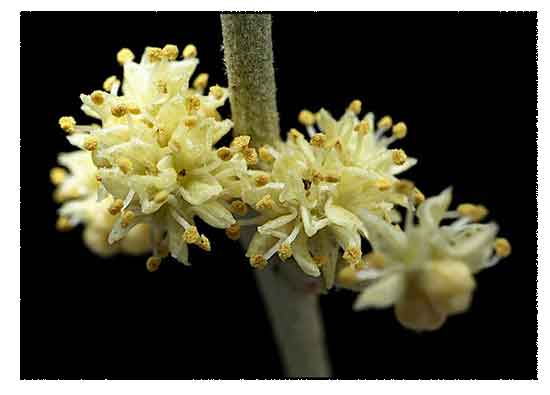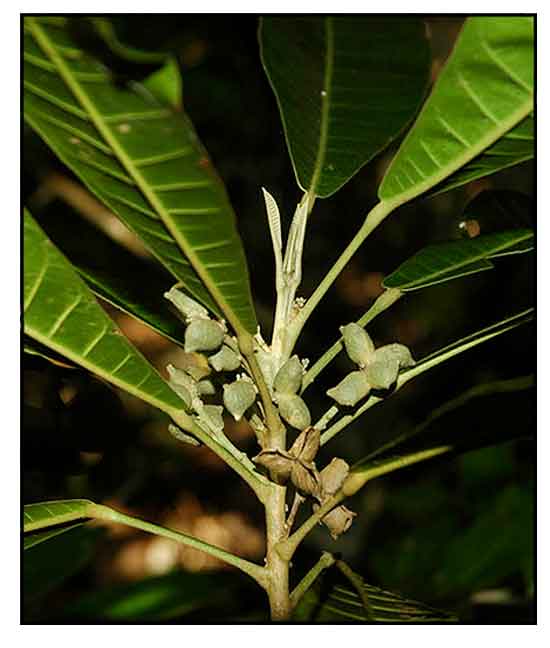 Gen info Gen info
• Lunasia amara is the only species of flowering plant in the genus Lunasia of the family Rutaceae.
• The genus was first published in 1837 by Francisco Manuel Blanco and the first species he described was Lunasia amara. (16)
Botany
• Lunas is an erect shrub, growing to a height of 3 meters. Twigs are smooth; the young tips olivaceous lepidote. Leaves are alternately crowded, obovate-oblong, 20 to 40 centimeters in length, 7 to 12 centimeters wide, often pointed at both ends. Male are female flowers are covered with lepidote scales, small and yellow, occurring in considerable numbers in axillary inflorescences which are shorter than the petioles. Fruit consists of three yellowish capsules, each about 1 centimeter long, marked with ribs, and opens along the veins and upper sutures.
 • Lunasia amara is a shrub that typically grows to a height of 2–3 m (6 ft 7 in – 9 ft 10 in), sometimes a small tree, with its young shoots, twigs and leaves covered in star-shaped hairs or scales. The leaves are simple, narrowly egg-shaped with the narrower end towards the base, 55–60 mm (2.2–2.4 in) long with toothed or lobed edges and many oil dots. Separate male and female flowers are arranged in clusters about 3–6 mm (0.12–0.24 in) in diameter, the male flowers sessile with petals about 1 mm (0.039 in) long and 3 stamens. Female flowers are on a short pedicel, the petals 2.0–2.3 mm (0.079–0.091 in) long and densely hairy carpels with 1 ovule per locule and 3 styles. The fruit has up to 3 follicles 6–15 mm (0.24–0.59 in) long and 5–10 mm (0.20–0.39 in) long and joined at the base, each containing a single seed. (16) • Lunasia amara is a shrub that typically grows to a height of 2–3 m (6 ft 7 in – 9 ft 10 in), sometimes a small tree, with its young shoots, twigs and leaves covered in star-shaped hairs or scales. The leaves are simple, narrowly egg-shaped with the narrower end towards the base, 55–60 mm (2.2–2.4 in) long with toothed or lobed edges and many oil dots. Separate male and female flowers are arranged in clusters about 3–6 mm (0.12–0.24 in) in diameter, the male flowers sessile with petals about 1 mm (0.039 in) long and 3 stamens. Female flowers are on a short pedicel, the petals 2.0–2.3 mm (0.079–0.091 in) long and densely hairy carpels with 1 ovule per locule and 3 styles. The fruit has up to 3 follicles 6–15 mm (0.24–0.59 in) long and 5–10 mm (0.20–0.39 in) long and joined at the base, each containing a single seed. (16)
Distribution
- Native to the Philippines.
-
In thickets and forests at low and medium altitudes.
- Also native to Bismarck Archipelago, Borneo, Jawa, Lesser Sunda Is., Maluku, New Guinea, Queensland, Sulawesi, Sumatera. (11)
 Constituents Constituents
- Preliminary studies have yielded saponins, alkaloids, tannins.
-
Bark and leaves yield an alkaloid or two alkaloids.
- Study yielded two alkaloids from the bark and wood: (1) lunasin, C16H21N2O5, m. p. 188˚, very bitter, soluble in water, and unstable even to milk alkalies, and (2) lunacrin, C16H20NO3, m. p. 116˚, slightly acrid and pungent, insoluble in cold water, very feebly basic, forming salts with mineral acids. Both are quinolin bases, having methoxymethyl-quinolin as one nucleus. Both exhibit similar physiological actions, lunasin slightly more toxic than lunacrin. The alkaloids have no anesthetic action on sensory and motor nerves and no action on the sympathetic ganglion. However,they have a distinct action on muscles, with a continually increasing tone and a rapid diminution of muscle response to stimulation. The lethal effect of the alkaloids is due to cessation of respiration simultaneously with that of circulation. Both alkaloids also exhibit a positive toxic action on protozoal organisms. (Q)
- Study yielded quinoline alkaloids - 4-methoxy-2-phenylquinoline, kokusagine, and graveoline. (see below)
- Study of wood extract revealed alkaloids, steroids, and polyphenols by thin layer chromatography, Dragendorf, acetic anhydride-sulfuric acid and ferric chloride methods respectively. (see study below) (17)
- Study of Lunasia amara Blanco var. amara for leaf essential oil yielded 0.1-0.15%, with principal sesquiterpenes of
γ-elemene (0.7-19%), germacrene-D (18-51%), and bicyclogermacrene (7-26%), with lesser amounts of bicycloelememe (102%), ß-bourbonene (0.7-3%), ß-elemene (4-9%), α-farnesene (1-3%), and δ-cadinene (3-5%). (23)
- Study of methanol extract of bark isolated two new furanoquinolones, 3-oxolunacrine (1) and 2,3-dehydrolunacrine (2), along with 22 known quinolones (3-24).
(28)
Properties
- Both alkaloids have exhibited a positive toxic action on protozoal organisms.
- Studies have suggested
topoisomerase inhibitory, antitumor, antitubercular, antibacterial, antifungal, anticancer, aphrodisiac, fertility enhancing, libido enhancing, antidiabetic, anti-inflammatory properties.
Parts used
Bark, seeds and leaves.
 Uses Uses
Folkloric
- Bark used for stomach troubles; also, used for snake bites.
- Bark and seeds used for gastralgia and adynamic conditions of the bowels.
- Leaves also used for stomach troubles.
- In Papua, New Guinea, used to treat tropical ulcers.
- In Indonesia, decoction of bark and leaves rubbed on swollen limbs; also used as treatment for skin diseases. Used for treatment of diabetes, food poisoning, malaria, skin diseases and snake bites.
- In Central Suwalesi, bark sap used as eyedrops for inflamed or irritated eyes. (10)
- In South Suwalesi, used by local people as antibacterial and aphrodisiac. (5)
- Ayta people of Porac, Pampanga burn dried leaves and stems as mosquito repellent.
(15)
- In Malesia, plant used to treat skin and digestive problems. In New Guinea, bark extracts used to treat tropical ulcers. (16)
- In Agusan del Sur, the bark of the tree (lunas-kahoy) or vine (lunas-bagon) is used as anti-inflammatory (for wounds, bites, skin diseases, fever, ulcer, nausea, heartburn and gastroenteritis); antimotility (diarrhea); antihistamines (for itching and skin allergies); antiparasitic (malaria); antibacterial (skin diseases and stomach troubles); antitoxic (food poisoning, tetanus, snake or insect venom); antiviral (chikungunya and dengue). Plants preparations are applied by rubbing infusion to the affected area or drinking the infusion or tincture if the malady is internal. (18)
- In Mindanao, the B'laan tribe in Mount Matutum use infusion, tincutres, or poultices of tawal-ulad (Lunasia amara) for treatment of snake bites, dengue, dysmenorrhea, constipation, rabies, German measles, rashes, varicose veins and hypertension. (22)
- The Ati tribe in Malay, Aklan, Philippines, instill latex from stem for sore eyes. (26)
Others
- Herbal tonic: Lunasia amara is a significant component of the Indonesian herbal tonic known as Jamun Kuat Lelaki Lawang Sanga, in combination with Pasak bumi (Eurycoma longifolia Jack), Panax gingseng, Tribulus terrestris, and Zingiber aromaticum. It is claimed to increase sexual appetite, sexual passion, stamina, extends length of sexual activity, and delays ejaculation. (20)
- Indonesian herbal viagra / Sanrego: Lunasia amara is lone component of Sanrego, marketed as Indonesian herbal viagra. Reports have claimed it to be a good sexual stimulator. (20)
- Veterinary: Sanrego wood extract can improved sperm quality for livestock reproduction. (see study below) (25)
Studies
• Lunacridine / DNA Intercalating Topoisomerase II inhibitors: An ethnobotanical survey of plants in Papua, New Guinea has identified L. amara as having anti-Staph aureus activity. Study of aqueous bark extract yielded a quinoline alkaloid, lunacridine as the active principle. Study with Strep pneumoniae suggested topoisomerase as the likely target for the drug; also, the compound showed to be a potent inhibitor of the isoform, explaining its activity against human cell lines. Results place the drug among the DNA intercalating class of topoisomerase II inhibitors. (Various inhibitors of DNA topoisomerase are being evaluated for antitumor activities.) (1)
• Review / Anti-Tubercular Alkaloids / Quinoline Alkaloids: Lunasia amara has yielded quinoline alkaloids - 4-methoxy-2-phenylquinoline, kokusagine, and graveoline which displayed significant invitro activity against M. tuberculosis. (2)
• Cytochrome P450 2D6 Inhibitory: Methanol extract study yielded 14 acridone alkaloids. Of the alkaloids, 5-hydoroxygraveoline and lunamarine showed moderate inhibition selective for CYP2D6. (3)
• Antifungal / Antimicrobial: Extract yielded alkaloids and terpenoids which showed activity against Trichophyton mentagrophytes, A. flavus, Candida parapsilosis, M. luteus, B. subtilis, S. aureus. The active constituents were lunidonine and lunacrine. (4)
• Lunacridine / Anticancer: Quinoline alkaloid lunacridine is an active principle of L. amara, reported as a DNA Intercalating Topoisomerase II inhibitor. Study evaluated the cytotoxic activity of lunacridine on P388 murine leukemia cells. Results showed a cytotoxic activity with IC50 of 39.52 µg/mL. Results suggest to design and develop lunacridine as a lead compound for an anticancer drug. (5) (6)
• Aphrodisiac Effect / Combination Herbal Infusion: A preliminary study showed a methanol extract of wood to have an aphrodisiac effect in Wistar white rats. Study showed a combination infusion of Lunasia amara, Centella asiatica and Curcuma domestica had an aphrodisiac effect on male Sprague-Dawley rats libido. (7)
• Constituents / Antimicrobial: Study on constituents yielded many alkaloids and some terpenoids. On antimicrobial activity screened against some human pathogenic bacteria, yeasts and sporulated fungi, L. amara showed pronounced and broad spectrum of antimicrobial activity. Fractionation isolated two antimicrobially active alkaloids: lunidonine and lunacrine. (8)
• Isolation of Active Aphrodisiac Fractions: Study evaluated a MeOH bark extract to assess for aphrodisiac activity and determine and compounds and active fraction. The highest aphrodisiac effect was seen with fraction B demonstrated with introduction, climbing, and coitus. Fraction B yielded alkaloids and terpenoids as main components. (9)
• Fertility Enhancement / Anti-Hyperglycemic Effect: Study evaluated an aqueous extract on male fertility and anti-hyperglycemic activity in adult male Sprague-Dawley rats with STZ induced diabetes. Results showed the extract significantly increase sperm count, viability and progressive motility. The AE also significantly reduced the FBS by 49.53%. (12)
• Fertility Enhancement: Study of Lunasia amara on Sprague Dawley male rats showed increased sperm count and sperm motility, together with positive testicular histological effect on spermatogenesis. (13)
• Inhibitory Activity Against M. tuberculosis / Quinoline Alkaloids: Communication reports on the inhibitory activity against M. tuberculosis of quinoline alkaloids (1-3) isolated from air-dried Lunasia amara leaves. Alkaloids 1 and 3 showed more potent inhibitory activity compared to alkaloid 2. Rifampicin was used as standard drug. (14)
• Cytotoxicity Against Cancer Cell Lines / Bark Extracts: Study evaluated the cytotoxic activity of wood extracts of L amara and its phytochemical standardization. The ethyl acetate extract exhibited higher cell growth inhibition than methanol and n-hexane extracts on HeLa and T47D cancer cell lines with IC50a of 71.15 and 79.04 µg/mL, respectively. Total alkaloids in the EA extract was 10.46% (w/w), while lunacrine by ultra-fast liquid chromatography-photodiode array detection was 3.55% (w.w). The high total alkaloid and lunacrnine concentration confirm the cytotoxic property of the ethyl acetate wood extract. (17)
• Potential in Treatment of Malaria / Immune Response Modulation: Study using network pharmacology evaluated the role of active compounds in Lamara in the treatment of malaria. Results demonstrated that active compounds of Lunasia amara are likely to have favorable pharmacokinetic profiles, which target genes associated with malaria. Enrichment analysis performed with gene ontology and pathway analysis demonstrated that Lamara alleviates malaria mostly by regulating the immune response. (19)
• Antimicrobial / Cellular Metabolic Inhibitory Properties / Bark: Study evaluated the antimicrobial and cellular metabolic inhibitory properties of ethanolic extract of bark of Lunas-bagon by agar well diffusion for antimicrobial assay and MTT assay for effects on cellular metabolism. Results showed the extracts can inhibit selected Gram(+) and Gram(-) bacterial isolates. MTT assay revealed doses lower than 100 µg/ml will not inhibit cellular metabolism of splenocytes, while higher doses show reduction of metabolic activity which may indicate onset of apoptosis in cells. (21)
• Antidiabetic Compounds / Stems and Leaves: Study evaluated the active compound from ethyl acetate extract of Sanrego stems and leaves and predicted its ability as an antidiabetic in-silico. Thin-layer chromatography (TLC) yielded alkaloid and flavonoid compounds including scopoletin. Liquid chromatography high-resolution mass spectrometry (LC-HRMS) yielded 11 active compounds in the EEA and all of them had antidiabetic activity. On molecular docking, four compounds showed antidiabetic activity through α-glucosidase inhibition and dipeptidyl peptides-2 (DPP-4) inhibition. Hesperidin showed highest energy affinity as α-glucosidase inhibitor and DPP4 inhibitor, followed by tangeritin, scopoletin, and trigonelline. (24)
• Effect on Sperm Quality / Sanrego Wood Extract: Sperm quality is vital for livestock reproduction. Study evaluated the effect of adding Sanrego wood extract (Lunasia amara) to the Andromed® diluent on the sperm quality of Belgian Blue Crossbreeds bull. Results showed addition of Sanrego wood extract could increase (p<0.05) motility and viability of spermatozoa stored at 5°XC. Results suggest improved sperm quality and potential to be utilized as diluent alternative to improve liquid sperm quality. (25)
• Anti-Inflammatory / Scopoletin / Wood: Study evaluated beta-beta wood (Lunasia amara) to identify its anti-inflammatory components. Wood material was extracted with 96% ethanol and fractionated with dichloromethane. Results showed the active inflammatory compound in beta-beta wood is scopoletin. (27)
• Effect on Male Fertility / Sperm Proteomic Analysis: Study evaluated the potential proteomic changes in sperm treated with 60 mg/kbw sanrego aqueous extract. Proteomic analysis revealed two downregulated proteins (cenexin-1 and GLUL) and 11 upregulated proteins (Eno1,PGK2,F1-ATP synthase, FO-ATP synthase, LDHC, GLUL1, ODF2, Sp17, asparaginase, DNAJB13, and tubulin) in treated rats. The proteins were identified to be mainly involved in energy metabolism, sperm motility, amino acid metabolism, and cell signaling. The improved sperm function in sanrego-treated rats may be a direct results of proteomic changes. (29)
• Aphrodisiac Activity on Diabetic Rats / Stem: Study evaluated the aphrodisiac effect of ethanol extract of sanrego stems on diabetic rats induced by a high fat diet. Results showed ethanol stem extract at dose of 100 mg/kg and 150 mg/kbw had an aphrodisiac effect compared to control and showed a highly significant difference with sildenafil citrate. (30)
• Anti-Inflammatory / Rheumatoid Arthritis Model / Wood Extract: Study evaluated the anti-inflammatory effect of ethanolic extract of Beta-beta wood (L. amara) (ELA) in Complete Freund's Adjuvant (CFA)-induced arthritis in mice. Administration of ELA (50, 100, and 250 mg/kibw) significantly reduced volume of edema in mice-treated CFA (p<0.05), activity equal to diclofenac sodium 2 mg/kbw. ELA also significantly reduced the level of serum TNFα and IL6 in arthritis model in mice (p<0.05), less than diclofenac sodium. Histopathological exam indicated ELA decreased edema and infilfration of inflammatory cells and synovial hyperplasia as well as protected joint destruction without osteoclast. Results suggest potential benefit for treatment of chronic inflammatory conditions like rheumatoid arthritis. (31)
• Anti-Inflammatory / Rheumatoid Arthritis Model / Wood Extract: Andropause in older men is associated with a decrease in testosterone levels due to aging, which is associated with a decrease in the number of Leydig cells. Study evaluated if oral administration of ethyl acetate extract of Sanrego would increase the number of Leydig cells and testosterone levels in male Wistar rats. Sanrego wood extract at 16.5 mg/275 g bw of rats was dissolved in 2 ml aquabidest and administered once daily by intragastric forced-feeding. Results showed oral administration of EA extract of Sanrego wood increased the number of Leydig cells and testosterone levels in old male Wistar rats. (32)
Availability
Wild-crafted.
Extracts in the cybermarket.
|

![]()



 Gen info
Gen info • Lunasia amara is a shrub that typically grows to a height of 2–3 m (6 ft 7 in – 9 ft 10 in), sometimes a small tree, with its young shoots, twigs and leaves covered in star-shaped hairs or scales. The leaves are simple, narrowly egg-shaped with the narrower end towards the base, 55–60 mm (2.2–2.4 in) long with toothed or lobed edges and many oil dots. Separate male and female flowers are arranged in clusters about 3–6 mm (0.12–0.24 in) in diameter, the male flowers sessile with petals about 1 mm (0.039 in) long and 3 stamens. Female flowers are on a short pedicel, the petals 2.0–2.3 mm (0.079–0.091 in) long and densely hairy carpels with 1 ovule per locule and 3 styles. The fruit has up to 3 follicles 6–15 mm (0.24–0.59 in) long and 5–10 mm (0.20–0.39 in) long and joined at the base, each containing a single seed. (
• Lunasia amara is a shrub that typically grows to a height of 2–3 m (6 ft 7 in – 9 ft 10 in), sometimes a small tree, with its young shoots, twigs and leaves covered in star-shaped hairs or scales. The leaves are simple, narrowly egg-shaped with the narrower end towards the base, 55–60 mm (2.2–2.4 in) long with toothed or lobed edges and many oil dots. Separate male and female flowers are arranged in clusters about 3–6 mm (0.12–0.24 in) in diameter, the male flowers sessile with petals about 1 mm (0.039 in) long and 3 stamens. Female flowers are on a short pedicel, the petals 2.0–2.3 mm (0.079–0.091 in) long and densely hairy carpels with 1 ovule per locule and 3 styles. The fruit has up to 3 follicles 6–15 mm (0.24–0.59 in) long and 5–10 mm (0.20–0.39 in) long and joined at the base, each containing a single seed. (

